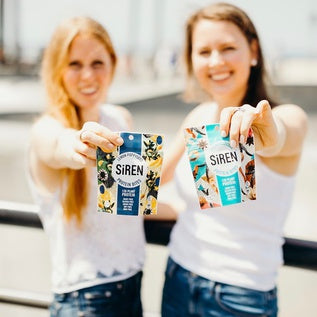
06.12.18
FOOD INDUSTRY SECRETS: THE GOOD, THE BAD, & THE UGLY
It’s now been over a year since we took the plunge and launched Siren Snacks. As newcomers to the food industry, we’ve learned a ton about how this world operates and what really goes on behind the glossy labels of your favorite CPG brands. Today we’re dishing out the good, the bad, and the ugly secrets of the food industry:

The GOOD:
Real People Make Real Food:
With the influx of robotics and smart devices slowly taking over the world (hello, Alexa), many people assume that food production has also been passed on to big machines and robots. But don’t let your SciFi fantasies go wild - most food production is still done with real hands by real people.
The Community is INCREDIBLY Supportive:
As food industry newcomers, we had a LOT of questions when getting started. Our #1 resource to get our questions answered? Other food companies and founders! It’s been amazing to see how supportive and open this community has been when it comes to giving advice and sharing wisdom. From our experience, the sentiment amongst food start-ups is camaraderie, not competition.
Brands Really do Give Back:
It’s inspiring to see so many food companies using their businesses to give back to their communities. From donating proceeds to Camp Fire victims to offering Siren Snacks to San Francisco food shelters, we’ve make a conscious effort to support our city. We’re definitely not alone, with dozens of generous, mission-driven food brands making a difference.

The BAD:
Certifications Cost $$$:
Ever wonder why some brands have labels and certifications like “Non-GMO Project Verified”, “Certified Gluten-Free”, or “Certified Vegan”, and other don’t? These labels demonstrate that a third-party has reviewed the brand’s ingredients and production process...but this certification process also comes with a hefty price tag. The Non-GMO Project Verification process can set a company back nearly $4,000, and certifications like Vegan and Gluten-Free can cost over $1,000 annually. Don’t get us wrong, we see a ton of value in these certifications - but for very early stage brands, they can be prohibitively expensive. So, if a new brand doesn’t have that Non-GMO seal, don’t automatically assume that the brand is using genetically modified ingredients. There’s a good chance they’ve chosen to hold off on their certifications until they can afford it.
Small Producers Pay MORE for the Same Ingredients as the Big Guys:
Ingredient suppliers and packaging manufacturers give substantial discounts to the larger brands who are buying ingredients in larger quantities. So, when you “shop small”, the prices are often higher because new brands cannot benefit from economies of scale.
How to Calculate How Much That Product ACTUALLY Cost:
You can work backwards from the price tags in a grocery store to understand the actual cost of an item. A good rule of thumb - the price you see in the store is about 3x the cost to produce that item. So, your $6 box of crackers probably cost about $2 to make. The 3x mark-up comes from the manufacturer’s margin, distributor markups, and grocery store markups.
Brands Pay For the Items on Sale, Not Retailers
See an item on sale in the grocery store? Don’t go thanking the store for those awesome deals. Chances are the brand is actually paying for that discount, not the store selling the product. In order to get that “sale” tag on the shelf, brands must either (1) sell their product to the store at a discount (and that discount is passed on to the customer), or (2) the grocery store will “charge back” the brand for all products that are sold at a discount.

The UGLY:
Using Trends to create a “Health Halo”:
Lately, we’ve seen lots of products positioning themselves as “healthy” because they align with a trendy ingredient or popular diet (think keto, CBD, or low carb). Just because a product is “keto-friendly” doesn’t mean it’s guaranteed to be good for you. We’ve seen plenty of ‘on-trend’ products that are still made with questionable, low quality ingredients.
Mislabeling - it's more common than you think:
We’ve worked closely with lawyers specializing in food safety to make sure our products are FDA compliant, and the process has taught us SO much about regulations on serving size, packaging claims, and nutrition labels. Did you know that depending on the category of a food product (ie: cookies, cakes, bars, granola, etc), there are specific rules outlining the legal serving size for that item? For example, the FDA requires that products classified as “crackers” have a serving size of 30g. But it’s not uncommon to see crackers with a much smaller serving size, which makes calories, sugar, and carbs appear lower than other competitors following the FDA guidelines. Additionally, there have been several stories emerging about products inaccurately reporting their calories and macronutrients on their nutrition labels. Scary stuff, right?
We believe all brands have the responsibility to be truthful and transparent with their customers. There will always be some ‘bad actors’ out there breaking the rules, but for us it's important to build and maintain customer trust. We like knowing what’s in our food, and if you’re reading this then there’s a good chance you do, too!

We Went Grocery Shopping With a Natural Chef and Nutrition Consultant
When we’re making our weekly round at the grocery store, we often find ourselves debating if we should toss a certain item in the cart. Anyone els... READ MORE

How to Keep Your Wellness Routine During Wedding Season
Spring has officially sprung. We love filling our vases up with seasonal daffodils and filling our refrigerator door up with wedding invitations. ... READ MORE

What This Pilates Instructor Eats to Stay Energized All Day
It’s one thing to be in class with your favorite fitness instructor, carefully watching, listening, and following their every cue. But what if you... READ MORE
